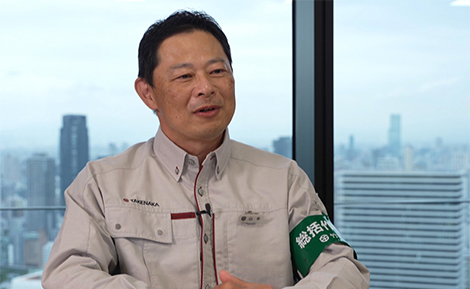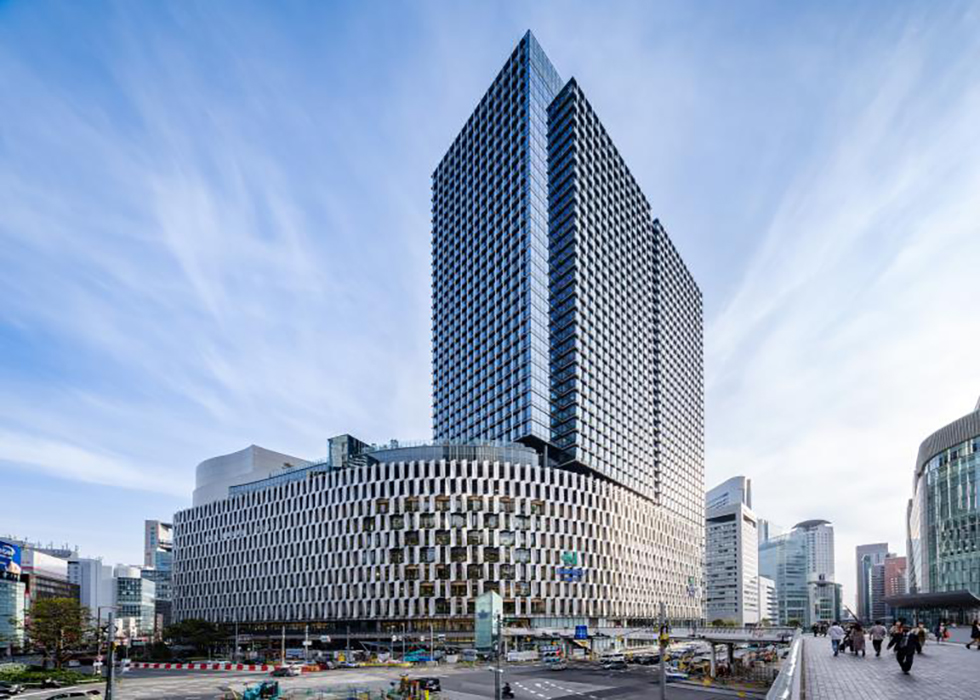
OSAKA UMEDA TWIN TOWERS SOUTH
Osaka Umeda is one of the leading business and commercial areas in the Kansai region. In 2022, a new landmark, the OSAKA UMEDA TWIN TOWERS SOUTH, opened in the so-called "Diamond District" south of JR Osaka Station. This large-scale project consists of a low-rise building with a department store and a high-rise building that contains offices and other facilities. Its eye-catching "organic facade" features a gently curving checkerboard pattern that stretches for 240 meters.
As the name "organic" suggests, the balconies of the low-rise buildings are planted with flora from the Rokko Mountains in Hyogo Prefecture, allowing visitors to feel the changing seasons. The area is also equipped with motion lighting, the brightness of which can be individually controlled by each lighting fixture. This creates a variety of effects that add a touch of color to the town at night.
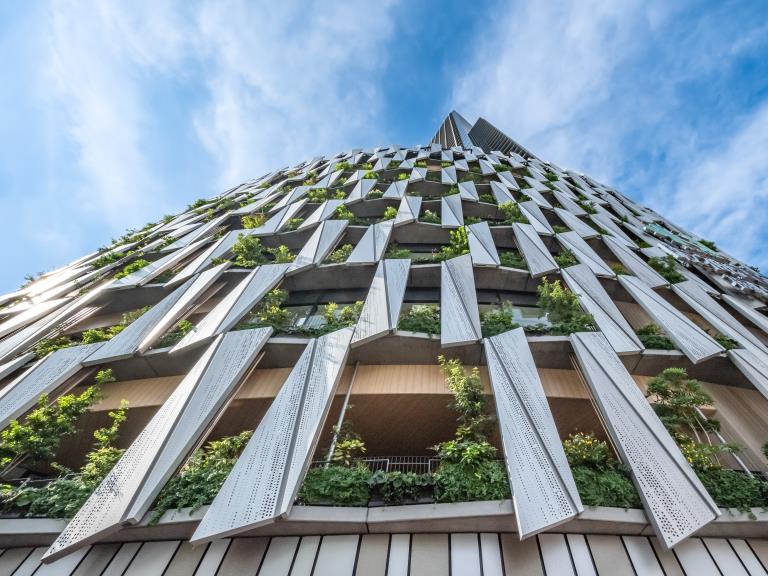
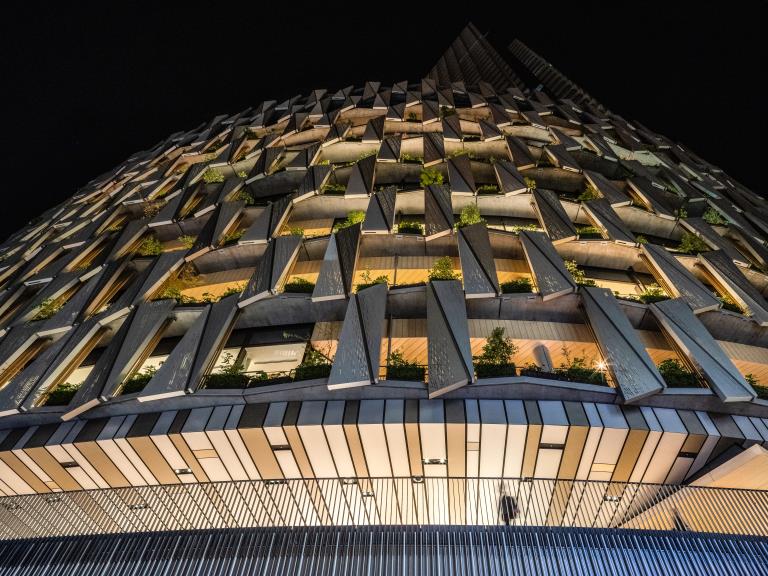
This project, which took our company 10 years to complete, faced many hurdles before it was completed.
Bringing the bustle of the underground mall above ground and throughout the entire Umeda area
When planning for this project began around 2013, Osaka's Umeda area was bustling with activity centered around one of Japan's largest underground shopping malls, but there was not much foot traffic above ground. In response to the customer’s dream to "spread vibrancy throughout the entire town" this project was launched under the concept of "Umeda Grove,” which embodies a vision that just as tree roots absorb water and nutrients, grow branches and leaves, and eventually become a forest the new building will spread the underground vibrancy above ground and out into the city.
The backbone of Umeda Grove is its “three-tier pedestrian network.” In order to encourage pedestrian flow on three levels—underground, above ground, and the sky deck—we worked not only on the building itself, but also on vertical circulation routes connecting the three levels and improving the surrounding environment.
We created an "urban atrium" that connects the ground and underground levels, widened the sidewalks at ground level, and consolidated scattered bicycle parking areas to expand pedestrian space. The sky deck provides a place where people can relax within the city.
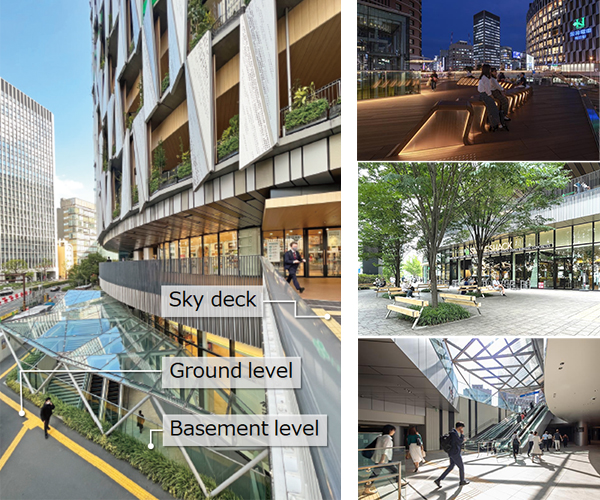
Creating a seamless building
In the case of buildings with complex shapes like OSAKA UMEDA TWIN TOWERS SOUTH, there is a risk that “twisting” during an earthquake could cause the building to sway even more violently. For this reason, a method is often used to prevent twisting by dividing the structure (building) into simpler shapes such as rectangular cuboids. However, this method also has its drawbacks. Where the structures are separated, "expansion joints" are installed to close gaps and allow people and goods to pass through, but these joints move significantly during an earthquake, so fixtures and equipment cannot be placed on top of them. This means that the layout of the department store's sales floors will be significantly restricted at Osaka Umeda Twin Towers South.
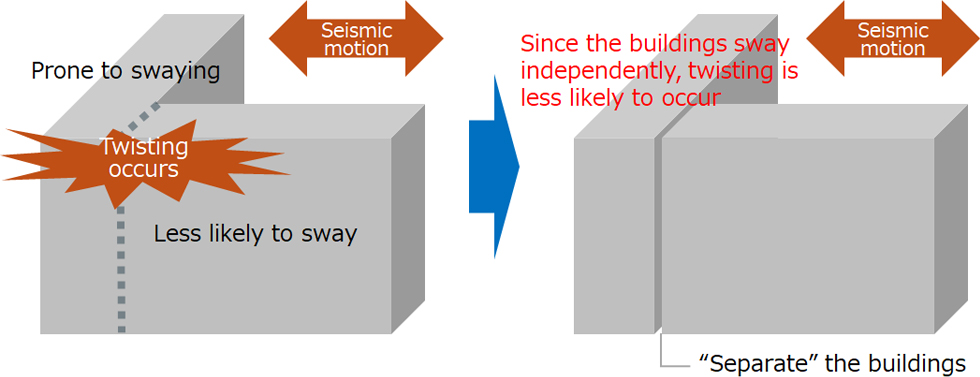
In order to create an earthquake-resistant building without using expansion joints, we adopted our newly developed "V-Frame Vibration Control Structure,” which combines various elemental technologies, such as oil dampers, belt trusses, and rail beams, to prevent twisting and reduce shaking during earthquakes in buildings with complex shapes.
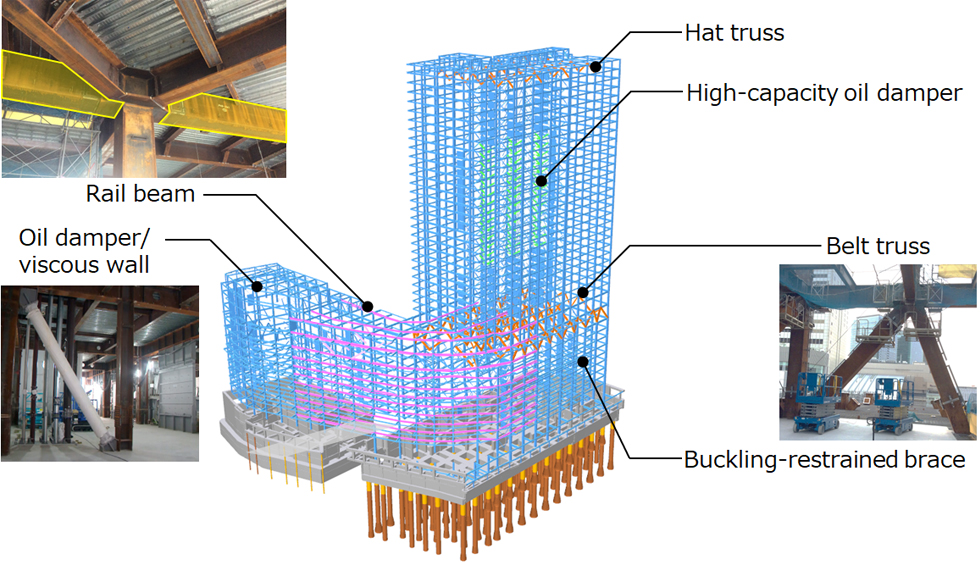
This technology has made it possible to create a user-friendly space without expansion joints. Additionally, by eliminating any "joints,” we were able to maintain continuity in the exterior design of the low-rise building as well as in the layout of the plants and lighting.
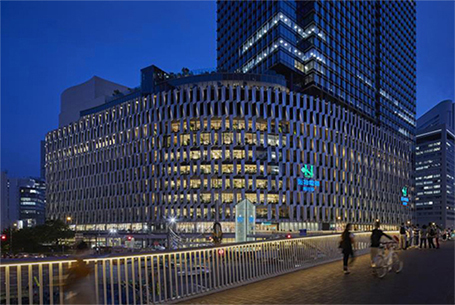
Rebuilding a department store without stopping business
There were two buildings on this site, separated by a road. OSAKA UMEDA TWIN TOWERS SOUTH was to replace these, but it was an absolute requirement that a department store located inside the building remain open. In order to overcome this challenge, the construction period of about eight years was divided into two major stages, and work proceeded in five steps on a 24-hour basis while relocating the department store and rerouting the underground shopping mall.
Rebuilding into a single building that straddles the road
One of the unique features of Osaka Umeda Twin Towers South is that two buildings will be rebuilt into one building that spans a 27-meter-wide road. Naturally, columns cannot be erected on the road, so a "suspension structure" has been adopted for the part above the road. This involves supporting the building by suspending it from columns and braces like a suspension bridge.
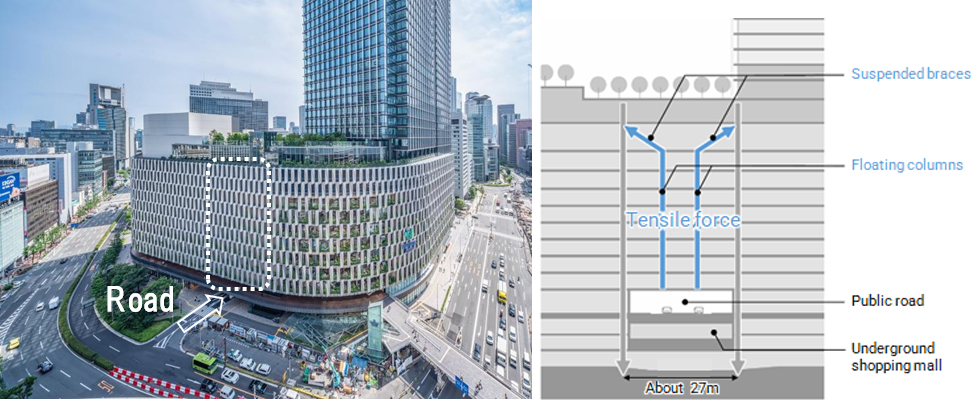
The challenge here was how to support the building until the "suspension structure" was completed. If we tried to support it with columns like a normal building, excessive force would be placed on the lower floors (see left side in the diagram below). Therefore, we devised a new construction method (patented), “deliberately cutting the suspension columns during construction.”

Temporary braces are installed every few floors to transfer the force (weight) of the area above the road to the adjacent building on both sides (center of the image above). After that, when the columns are cut, some of the force that had previously been transmitted to the lower floors is transferred to the building on both sides. Once the "suspension structure," including the suspension braces, is complete, the columns are connected, the building is lifted up, and the temporary braces are removed (right side of the image above).
Another challenge was to prevent construction materials from falling or scattering during construction of the high-rise building, which will stand 190 meters above ground. To that end, a self-climbing cover unit, was installed around the perimeter of the building. The cove unit rises before the steel frame is erected, thereby ensuring safety and security at all times.
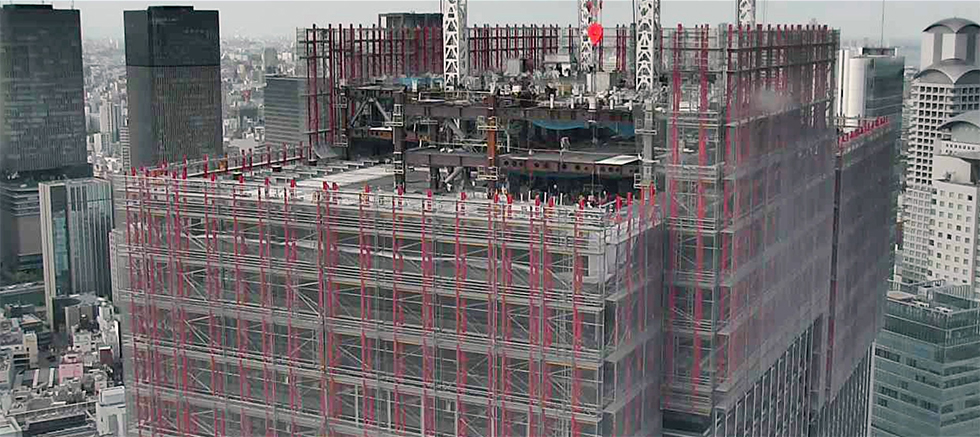
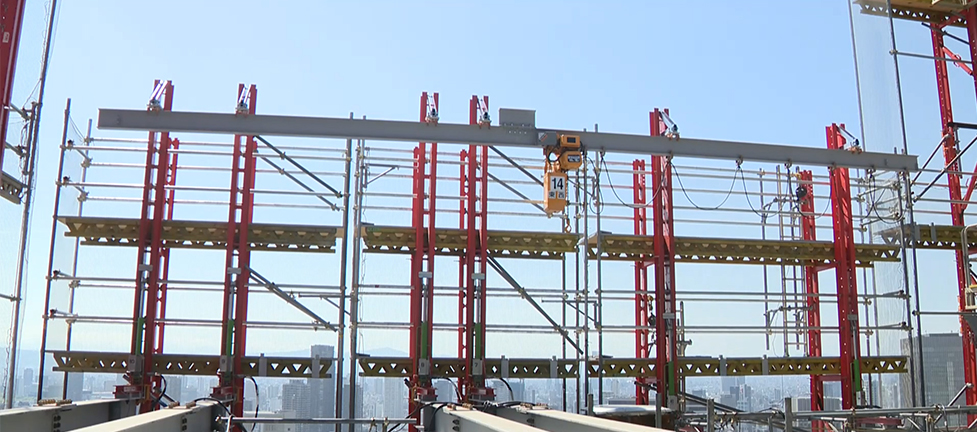
Our urban creation efforts will continue into the future
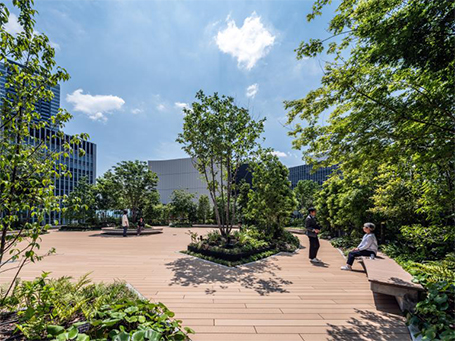
Nearly three years have passed since completion of OSAKA UMEDA TWIN TOWERS SOUTH. Upon visiting the site, you will sense increased liveliness above ground. Office workers and visitors relax in a verdant rooftop garden of the low-rise building where they experience seasonal plants and flowers as well as birds and insects that are also occasionally spotted.
The area surrounding Osaka Umeda Twin Towers South is home to numerous buildings that Takenaka has been involved with for half a century. We are currently working on development of an urban park and constructing condominiums in the “Umekita Area” north of JR Osaka Station, aiming for full opening of the district in spring 2028.
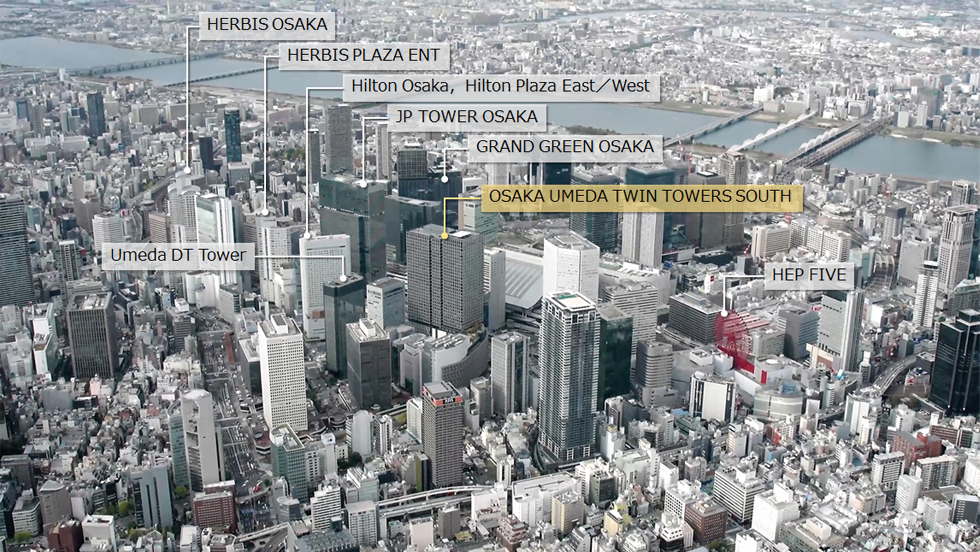
Comments from the person in charge
Designer: Yoshichika Umeda
The vision behind Umeda Grove was not merely to construct a building, but rather to channel the vitality from below ground up to the surface along with a flow of people, thereby creating a vibrant town that makes the best use of abundant greenery and open spaces. We hope it will become the core of the pedestrian network in Osaka's Umeda area, where many people will be able to enjoy leisurely strolls and spend their time comfortably.
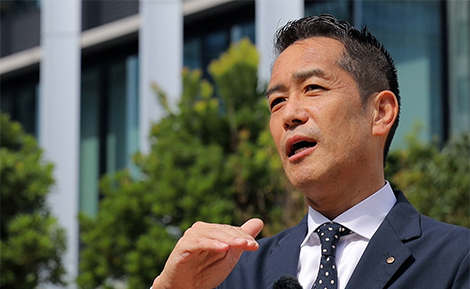
Designer: Kenji Yachi
The “three-tiered pedestrian network” was designed to unify the values and dreams of both customers and government with urban creation design. We created a plaza in the space made by expanded sidewalks, increased greenery, and arranged cafes to encourage people to move about. It would be my greatest joy if we were able to contribute to the development of the Osaka Umeda area.
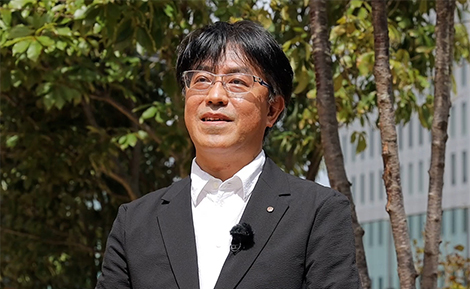
Designer: Seiho Suzuki
I wanted to create a building whose impression constantly changes so that new discoveries can be made every day. The “organic facade” allows visitors to enjoy seasonal flowers throughout the year, while its appearance constantly changes with shifting shadows. Even within high-rise and low-rise buildings, the passage of time can be experienced by carefully considering how light is introduced.
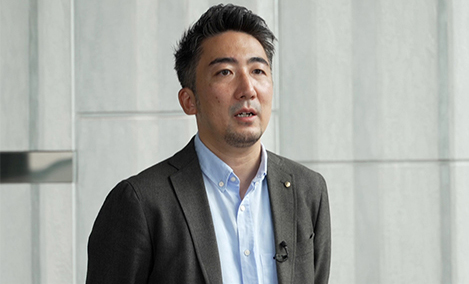
Construction Manager: Satoshi Koba
The most challenging aspect of the project was safely building the structure spanning a road without disrupting traffic as well as ensuring that construction did not impact nearby subway lines—all while maintaining operations in the department store and underground shopping mall. I take great pride in the fact that, through the united efforts of everyone involved in the construction, we were able to complete the project with minimal disruptions.
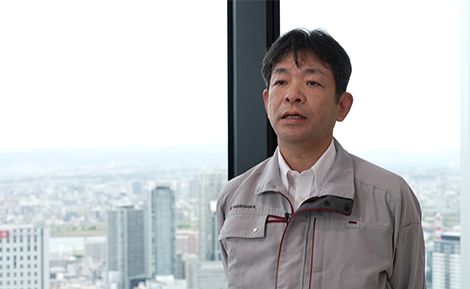
Construction Manager: Shigeru Matsuda
I am very pleased that we were able to successfully complete a project to “create the heart of Osaka” in the center of Osaka's business and commercial district, where 2.5 million people pass through daily, while also ensuring safety and security. It was also an honor to have been involved in the development of Osaka's Umeda district, which our company has helped shape for half a century.
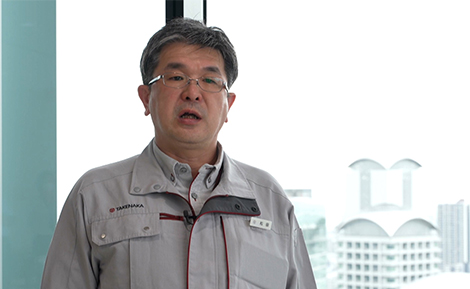
Construction Manager: Keisuke Yamamoto
As this was an eight-year construction project in an urban area, we had to be on edge 24 hours a day, but through the success of this project, we believe we have been able to continue our company's tradition of urban development and the trust of our customers. We will continue to move forward together with the local community through urban development.
